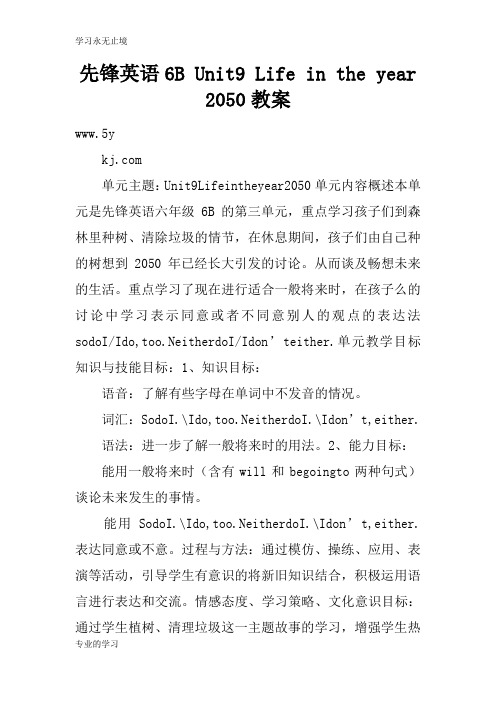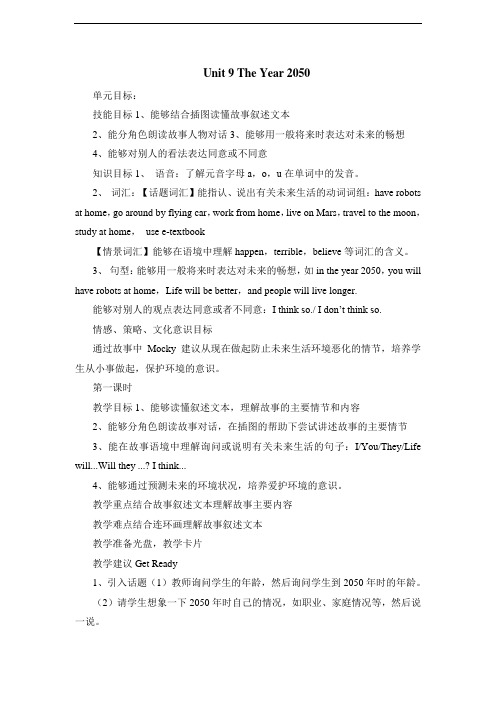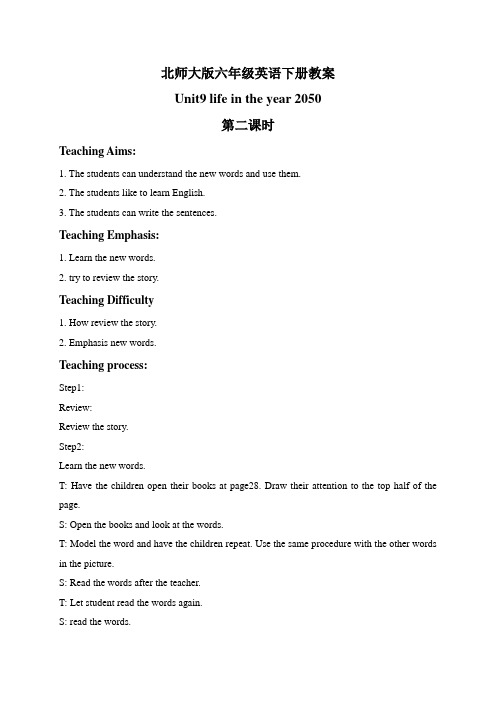Unit 9 The Year 2050 Lesson 1 教案-优质公开课-北师大三起6下精品
- 格式:doc
- 大小:29.00 KB
- 文档页数:3



先锋英语6B Unit9 Life in the year2050教案www.5y单元主题:Unit9Lifeintheyear2050单元内容概述本单元是先锋英语六年级6B的第三单元,重点学习孩子们到森林里种树、清除垃圾的情节,在休息期间,孩子们由自己种的树想到2050年已经长大引发的讨论。
从而谈及畅想未来的生活。
重点学习了现在进行适合一般将来时,在孩子么的讨论中学习表示同意或者不同意别人的观点的表达法sodoI/Ido,too.NeitherdoI/Idon’teither.单元教学目标知识与技能目标:1、知识目标:语音:了解有些字母在单词中不发音的情况。
词汇:SodoI.\Ido,too.NeitherdoI.\Idon’t,either.语法:进一步了解一般将来时的用法。
2、能力目标:能用一般将来时(含有will和begoingto两种句式)谈论未来发生的事情。
能用SodoI.\Ido,too.NeitherdoI.\Idon’t,either.表达同意或不意。
过程与方法:通过模仿、操练、应用、表演等活动,引导学生有意识的将新旧知识结合,积极运用语言进行表达和交流。
情感态度、学习策略、文化意识目标:通过学生植树、清理垃圾这一主题故事的学习,增强学生热爱自然、保护环境的意识。
通过畅谈2050年的未来生活,培养学生热爱生活的态度,激发学生探索未来的欲望。
教学重点能用SodoI.\Ido,too.NeitherdoI.\Idon’t,either.表达同意或不同意。
教学难点能用SodoI.\Ido,too.NeitherdoI.\Idon’t,either.表达同意或不同意。
学生情况分析学生在前面的学习中已经接触了will 引导的将来时学生曾经学过,因此在故事教学前可以让学生说一说对未来世界的想象,发挥想象力进行表达,从而为后面的故事教学作铺垫。
本单元容易出现的问题及措施本单元重点学习表达同意或者不同意的几种观点的说法,因此对于句型结构要让学生理解清楚,再进行练习,以降低学习的难度。

六年级英语下册Unit9《The Year 2050》教案北师大版(三起)一、教学目标1.学习掌握词汇:future, smart, robot, housework, imagine, age, space,colonize, planet, human, colony, galaxy。
2.学会运用What will…be like?正确提问和回答。
3.熟悉能够使用“见证者”描述自己想象中的未来生活。
二、教学重点1.学习掌握用“见证者”进行自我描述。
2.学会利用will来进行未来生活的想象及表达。
三、教学难点1.正确描述自己想象中的未来生活及增加对话练习。
2.熟练掌握“will”在未来时的用法及运用。
四、教学准备1.PPT课件或者白板和笔。
2.学习用品:学生课本、笔、笔记本。
3.视听材料:指南针英语三起小学六年级下Unit 9《The Year 2050》视频、听力材料、习题集。
五、教学过程1. 导入1.给学生播放一段预测未来生活的短片子,鼓励学生就影片内容进行讨论。
2.老师引导学生思考,未来生活可能会发生那些变化和进步。
2. 学习重点1.New words and expressions。
讲解单词:future, smart, robot, housework, imagine, age, space, colonize, planet, human, colony, galaxy。
2.回答What will…be like? 的问题。
老师利用图片和实物进行示范,并鼓励学生进行句型练习。
3. 教学内容1.视频观看。
给学生播放《The Year 2050》视频,带领他们仔细观看视频,注意观察信息和角色所做的事情,以及未来风貌等细节。
2.课文阅读与理解。
鼓励学生读课文,并带领学生研读课文中的词语及对话,答疑并理解重点部分。
4. 教学练习1.句型练习。
教师发放练习册,让学生写出五个句子,并回答What will…be like?的问题。

Unit 9 The Year 2050单元目标:技能目标1、能够结合插图读懂故事叙述文本2、能分角色朗读故事人物对话3、能够用一般将来时表达对未来的畅想4、能够对别人的看法表达同意或不同意知识目标1、语音:了解元音字母a,o,u在单词中的发音。
2、词汇:【话题词汇】能指认、说出有关未来生活的动词词组:have robots at home,go around by flying car,work from home,live on Mars,travel to the moon,study at home,use e-textbook【情景词汇】能够在语境中理解happen,terrible,believe等词汇的含义。
3、句型:能够用一般将来时表达对未来的畅想,如in the year 2050,you will have robots at home,Life will be better,and people will live longer.能够对别人的观点表达同意或者不同意:I think so./ I don’t think so.情感、策略、文化意识目标通过故事中Mocky 建议从现在做起防止未来生活环境恶化的情节,培养学生从小事做起,保护环境的意识。
第一课时教学目标1、能够读懂叙述文本,理解故事的主要情节和内容2、能够分角色朗读故事对话,在插图的帮助下尝试讲述故事的主要情节3、能在故事语境中理解询问或说明有关未来生活的句子:I/You/They/Life will...Will they ...? I think...4、能够通过预测未来的环境状况,培养爱护环境的意识。
教学重点结合故事叙述文本理解故事主要内容教学难点结合连环画理解故事叙述文本教学准备光盘,教学卡片教学建议Get Ready1、引入话题(1)教师询问学生的年龄,然后询问学生到2050年时的年龄。
(2)请学生想象一下2050年时自己的情况,如职业、家庭情况等,然后说一说。

北师大版六年级下册Unit9 The Year 2050Lesson 1教学设计一、教材内容分析本节课为北师大版(三年级起)小学英语六年级下册第九单元The Year 2050的第一课时Enjoy the Story,故事围绕Ken,Ann和Mocky一起讨论未来的生活而展开。
故事讲述的是未来的生活,所以很自然地运用了一般将来时。
本课的功能句型是用一般将来时讲述未来的生活,并对别人的想法发表自己的意见,表示同意或不同意。
同时故事结尾结合环境污染、资源枯竭等现状告诉学生要保护环境。
本单元是六年级下册最后的课文单元,因此内容丰富,综合性强。
二、学生情况分析本课内容以六年级学生为教学对象。
六年级学生已经具备一定的听说读写能力,经过两年的英语学习,课堂上已经基本能够听懂老师提问,并且陈述自己观点。
学生在第八单元刚刚学过一般将来时的表达,学生对此并不陌生。
三、教学目标(一)知识目标1. 能够读懂叙述文本,理解故事的主要情节和内容。
(二)能力目标1.能够在思维导图的帮助下尝试讲述故事主要情节。
2.能在故事语境中理解询问或说明有关未来生活的句子:I/We/They/Life will… Will they…? I think…(三)情感目标1.能通过预测未来的环境状况,培养爱护环境的意识。
四、教学重点结合故事叙述文本理解故事主要内容。
五、教学难点结合思维导图讲述故事主要情节。
六、教学准备PPT,卡片七、教学过程1. 激趣引入(1)教师热情地和学生互相问好。
(2)教师利用PPT课件播放水晶球动画,通过水晶球预示2050年的生活这一方法引入新课,引出Get Ready部分内容,以及部分重点句型:Will…?/ I think so. / I don’t think so.设计意图:趣味导入新课,激起学生对本课话题的兴趣。
初步呈现句型。
2. 呈现故事(1)背景介绍T:One day, Ken and Ann want to know something about 2050, too. They have no idea. But Mocky knows. Can you guess, how does he know that? Ss: He has a crystal ball, too.(2)播放故事视频教师播放Enjoy the Story板块动画视频,让学生整体感知故事。
北师大版六年级英语下册教案Unit9 life in the year 2050第一课时Teaching Aims:1. The students can understand the story.2. The students like to learn English.3. The students can read the story.Teaching Emphasis:1. How to understand the story.2. How to remember some new words.Teaching DifficultyHow to understand the story and read the story.Teaching process:Step1:ReviewT: Have the children try to think some phrases about the sports.S: Try to think about the phrases.T: Write the phrases on the blackboard and have the children read these phrases.S: Read after the teacher.Step2:Set the sceneT: Ask the children what their plans are for this weekend and next week.S: Try to answer the questions.T: Tell the students in today’s story they are going to read about the BINGO Kids will pick up trash and plant new trees.Step3:Presentation of new languageT: Ask a question “What are you doing tomorrow?”S: Try to answer the question.T: Write the sentences on the blackboard, have the children read the sentences after the teacher.S: Read the sentences.T: Have the children try to make the sentences by themselves.S: Try to do it.T: Write these sentences on the blackboard, have the children try to understand the meaning.S: Read these sentences.Step4:Talk about the story.T: Have the children looked at the pictures and the teacher tells the story to the student.S: Listen to the story and try to understand the story.T: Have the children read the story by themselves and try to answer some questions. Read the story and answer the questions.T: Explain some difficult words.Step5:Learn the storyT: Have the children read the story again and answer the questions.S: Read the story and answer the questions.T: Play the tape and have the children read the story after the tape.S: Read the story after the tape.T: have the children take roles and act out the story.S: Try to do it.Homework:Ask students to read the story again and practice sating the new vocabulary from the story. Encourage them to retell the story by following the Narration at the bottom of student book pages 26 and 27.课后反思:学生能够理解课文内容,并对课文感兴趣。
Unit 9 The Year 2050
Lesson 1
教案
一、教学目标
知识与技能目标:
1、知识目标:
语音:了解有些字母在单词中不发音的情况。
词汇:So do I.\ I do, too. Neither do I.\ I don’t, either.
语法:进一步了解一般将来时的用法。
2、能力目标:
能用一般将来时(含有will和be going to两种句式)谈论未来发生的事情。
能用So do I.\ I do, too. Neither do I.\ I don’t, either. 表达同意或不同意。
3、情感态度、学习策略、文化意识目标:
通过学生植树、清理垃圾这一主题故事的学习,增强学生热爱自然、保护环境的意识。
通过畅谈2050年的未来生活,培养学生热爱生活的态度,激发学生探索未来的欲望。
二、教学重难点
能用So do I.\ I do, too. Neither do I.\ I don’t, either. 表达同意或不同意。
能用So do I.\ I do, too. Neither do I.\ I don’t, either. 表达同意或不同意。
三、教学用具
教具:录音机、课件,单词图片。
四、教学过程
Step1:Warming-up
Oral practice.
T: What’s the weather like today:?
T: What rules about mountain bike race?
设计意图:通过教师和学生之间的口语交际,拉近教师和学生的距离,营造英语学习氛围。
Step2:Preview
Set the scene.
Ask students if they have ever done anything to help clean up the environment, by picking up trash. Explain the meaning of to plant trees.
Step3:Presentation
Present the new language.
(1) Say that in the story the BINGO Kids are talking about their ideas about life in the year 2050.
(2) Ask a concept question: “Are we talking about the past, present, or future. ”
(3) Listening drill.
(4) Choral repetition: Students listen and repeat after you three times.
(5) Individual check.
(6) Present the second model: in the year 2050 computers will do everything : Repeat steps 2-5 above.
(7) Practice the first and second models.
(8) Elicit the other five models by following steps 2-5
Revise all seven models.
Watch the video for second time and answer some questions:
Q1: What does Sue think about the future?
Q2: What does Ann think about the future?
Q3: What does Ken think about the future?
学生在听课文时找到上面三个问题的答案。
同时学习huge, different, 等并理解其意思。
设计意图:让学生带着问题去读课文,阅读前对问题进行翻译,照顾部分中下等学生。
从细节上感知故事内容.
Ask the children read the text for picture 1 to 10 with the video and find answers.
Q4: Computers will do everything .Do you agree?
Q5: Where does Lisa want to live in the future?
设计意图:通过让学生再次读课文,让学生理解同意或不同意的观点怎么表达,为学生很好的理解复述内容作铺垫,提高学生的理解能力。
Step4:Practice
1. Now play the tape and have students look at the picture.
2. Play the tape again and have the students read the words.
Step5: Consolidation and extension
Read and fill in the blanks.
The BINGO Kids are _____ a field trip in the forest. They are _____ up trash. There are _____ bottles and tin cans in the forest. In some areas, there aren’t many _____. So the kids are _____ new trees. In the year 2050, these trees will be _____.
During the break, the kids talk about life in the _____. Some kids say the _____ will do many things, such as shopping and _____ dishes, but computers can’t _____ trees. Everyone will _____ in modern cities, but some people still love the _____.
设计意图:拓展知识,让学生独立阅读故事理解故事,同时通过排列句子的练习对学习的内容进行反馈。
五、课后作业
1.熟记本单元的单词和句子。
2.与父母对话本单元的对话。